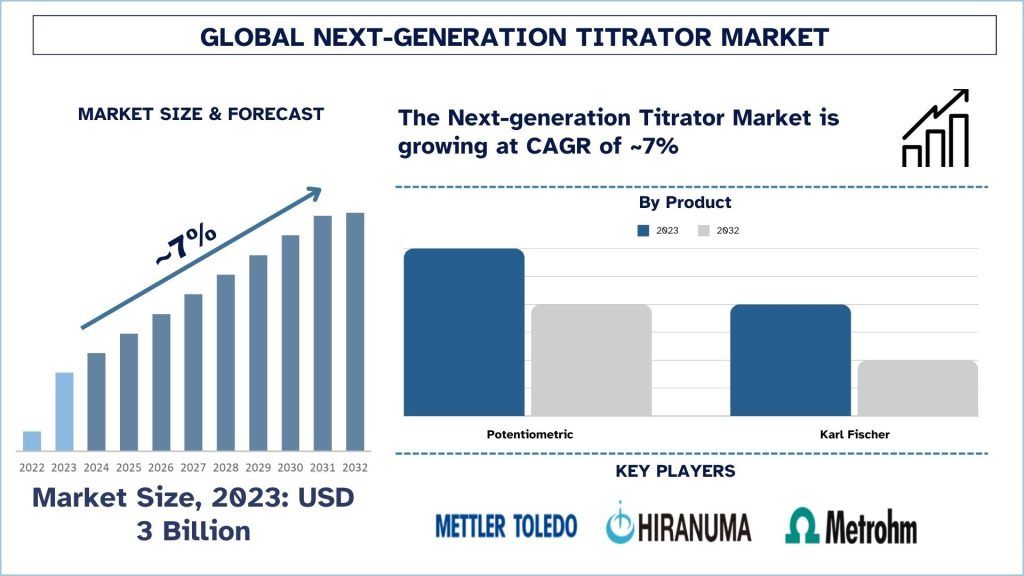Рынок титраторов нового поколения: текущий анализ и прогноз (2024-2032 гг.)
Акцент на продукт (потенциометрический и по Карлу Фишеру); Конечный пользователь (фармацевтические компании, биотехнологические компании, академические и исследовательские институты, другие); и Регион/Страна
Размер и прогноз глобального рынка титраторов нового поколения
Объем глобального рынка титраторов нового поколения в 2023 году оценивался примерно в 3 миллиарда долларов США и, как ожидается, будет расти с высокими темпами CAGR около 7% в течение прогнозируемого периода (2024-2032 гг.) благодаря расширению фармацевтического производства, требующего точного титрования для контроля качества.
Анализ глобального рынка титраторов нового поколения
Глобальный рынок титраторов нового поколения охватывает передовые аналитические инструменты, предназначенные для точных и автоматизированных процессов титрования, используемых в различных отраслях промышленности, особенно в фармацевтической, химической, пищевой промышленности и производстве напитков. Эти титраторы обеспечивают повышенную точность, эффективность и простоту использования по сравнению с традиционными методами. Рост рынка обусловлен такими факторами, как растущий спрос на высокоточные аналитические инструменты, распространенность новых заболеваний, требующих современных составов лекарств, строгие правила контроля качества и технологические достижения в области автоматизации и цифровизации. Кроме того, увеличение объемов НИОКР в различных отраслях промышленности и потребность в быстрых и точных аналитических результатах еще больше стимулируют рынок, позиционируя титраторы нового поколения как важные инструменты для обеспечения качества продукции и соответствия требованиям.
Тенденции глобального рынка титраторов нового поколения
В этом разделе рассматриваются ключевые тенденции рынка, которые влияют на различные сегменты глобального рынка титраторов нового поколения, как это определено нашей командой экспертов по исследованиям.
Сегмент Карла Фишера преобразует отрасль
Сегмент Карла Фишера в титраторе нового поколения определяется применением современных методов титрования, направленных на определение процентного содержания воды в различных соединениях. Рост в этом сегменте объясняется растущей потребностью в высокой точности и производительности измерения влажности в фармацевтической, химической, пищевой промышленности и производстве напитков, а также в нефтехимической отрасли, где содержание воды играет важную роль в качестве продукции и соответствии требованиям законодательства по безопасности. Факторы, которые увеличивают принятие на рынке, включают технологические улучшения, такие как автоматизация и улучшение чувствительности титраторов Карла Фишера. Этот сегмент также характеризуется постоянными инновациями и пристальным вниманием к повышению точности и скорости анализа и, таким образом, является ключевым элементом в перспективах титраторов нового поколения.
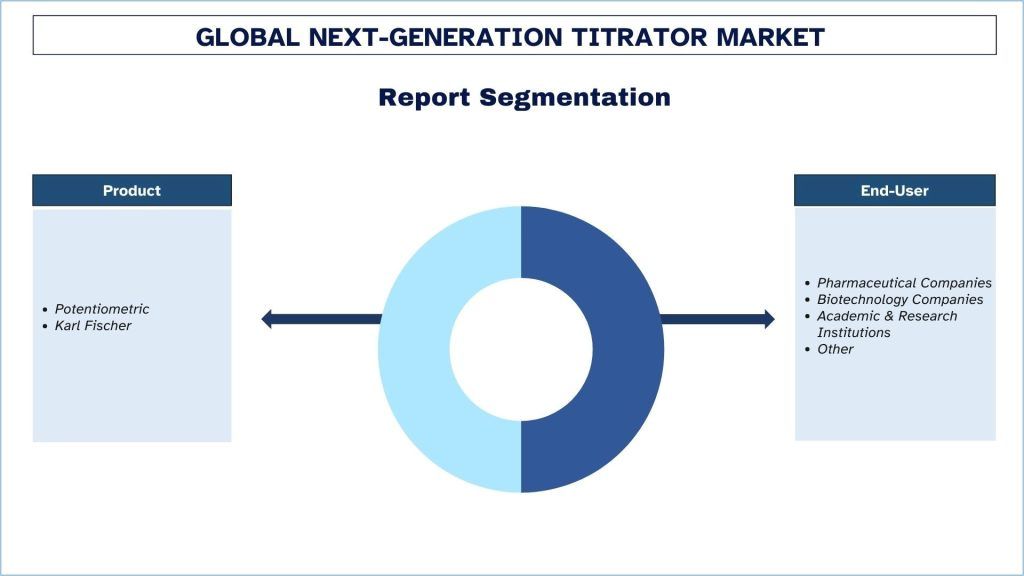
Ожидается, что Азиатско-Тихоокеанский регион будет расти самыми быстрыми темпами CAGR в течение прогнозируемого периода.
Из-за растущих темпов индустриализации в Азиатско-Тихоокеанском регионе и растущего развития фармацевтической, химической, пищевой промышленности и производства напитков, рынок титраторов нового поколения быстро расширяется в этом регионе. Поскольку правительственные и промышленные требования к требованиям качества и безопасности растут, потребность в сложном оборудовании для титрования, которое является более точным и ближе к автоматическому, возрастает. Также уделяется повышенное внимание научно-исследовательским и опытно-конструкторским работам и достаточные инвестиции в научную инфраструктуру, что, в свою очередь, также подпитывает рынок. В разбивке по регионам Азиатско-Тихоокеанский регион продемонстрирует высокий рост на рынке титраторов нового поколения из-за присутствия таких стран, как Китай, Индия и Япония, которые имеют сильную производственную отрасль и инвестируют в технологическое развитие.
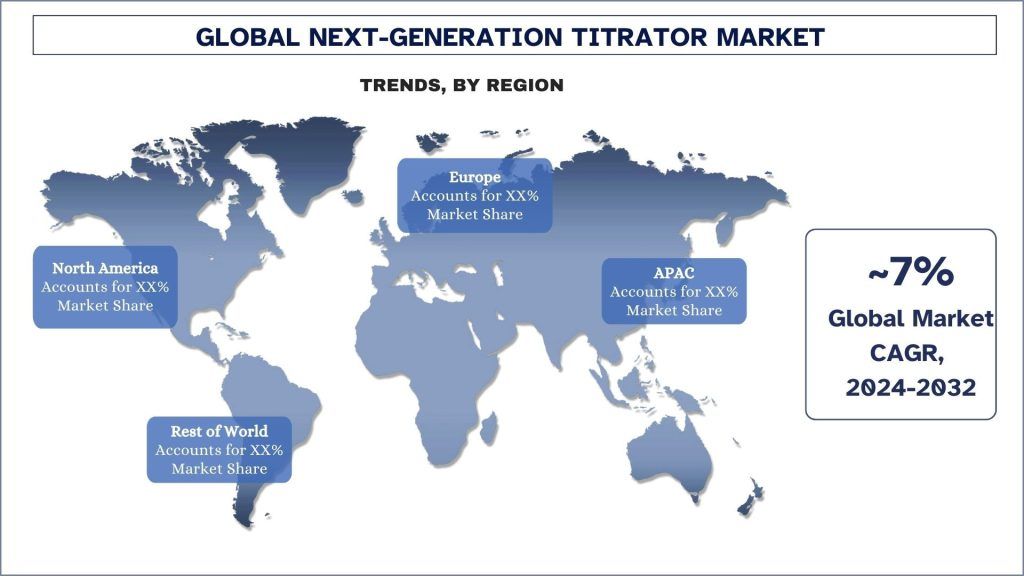
Обзор глобальной индустрии титраторов нового поколения
Глобальный рынок титраторов нового поколения является конкурентным, с несколькими глобальными и международными игроками рынка. Ключевые игроки применяют различные стратегии роста для расширения своего присутствия на рынке, такие как партнерства, соглашения, сотрудничество, запуск новых продуктов, географическое расширение, слияния и поглощения. Некоторыми из основных игроков, работающих на рынке, являются METTLER TOLEDO; Hanna Instruments, Inc.; XYLEM LEARNING; Hatch Ltd.; DKK-TOA CORPORATION; KEM; Metrohm AG; Thermo Fisher Scientific Inc.; ECH Elektrochemie Halle GmbH; HIRANUMA Co., Ltd.
Охват отчета о глобальном рынке титраторов нового поколения
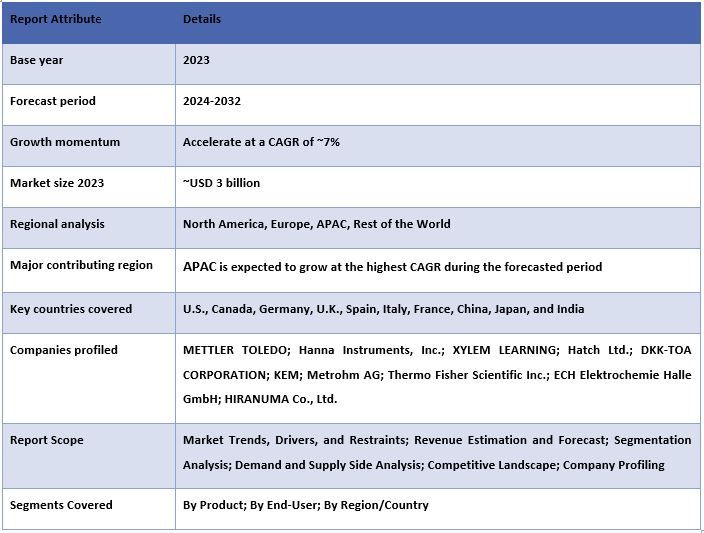
Причины для покупки этого отчета:
- Исследование включает анализ размеров рынка и прогнозирования, подтвержденный проверенными ключевыми экспертами отрасли.
- В отчете представлен краткий обзор общей производительности отрасли с первого взгляда.
- Отчет охватывает углубленный анализ видных игроков отрасли с основным упором на ключевые финансовые показатели бизнеса, портфели типов, стратегии расширения и последние разработки.
- Подробное изучение драйверов, ограничений, ключевых тенденций и возможностей, преобладающих в отрасли.
- Исследование всесторонне охватывает рынок по различным сегментам.
- Глубокий анализ отрасли на региональном уровне.
Варианты настройки:
Глобальный рынок титраторов нового поколения может быть дополнительно настроен в соответствии с требованиями или любым другим сегментом рынка. Кроме того, UMI понимает, что у вас могут быть свои собственные бизнес-потребности, поэтому не стесняйтесь обращаться к нам, чтобы получить отчет, который полностью соответствует вашим требованиям.
Содержание
Методология исследования для анализа глобального рынка титраторов нового поколения (2024–2032 гг.)
Анализ исторического рынка, оценка текущего рынка и прогнозирование будущего рынка глобального рынка титраторов нового поколения были тремя основными этапами, предпринятыми для создания и анализа внедрения глобальных титраторов нового поколения в основных регионах. Было проведено исчерпывающее вторичное исследование для сбора исторических данных о рынке и оценки текущего размера рынка. Во-вторых, для подтверждения этих выводов было принято во внимание множество результатов и предположений. Кроме того, были проведены исчерпывающие первичные интервью с отраслевыми экспертами по всей цепочке создания стоимости глобального рынка титраторов нового поколения. После предположения и подтверждения рыночных показателей посредством первичных интервью мы применили подход «сверху вниз»/«снизу вверх» для прогнозирования полного размера рынка. После этого были приняты методы разбивки рынка и триангуляции данных для оценки и анализа размера рынка сегментов и подсегментов соответствующей отрасли. Подробная методология описана ниже:
Анализ исторического размера рынка
Шаг 1: Углубленное изучение вторичных источников:
Было проведено подробное вторичное исследование для получения исторических данных о размере глобального рынка титраторов нового поколения с использованием внутренних источников компании, таких как годовые отчеты иamp; финансовые отчеты, презентации результатов деятельности, пресс-релизы и т. д., а также внешние источники, включая журналы, новости иamp; статьи, правительственные публикации, публикации конкурентов, отраслевые отчеты, сторонние базы данных и другие надежные публикации.
Шаг 2: Сегментация рынка:
После получения исторических данных о размере глобального рынка титраторов нового поколения мы провели подробный вторичный анализ для сбора исторических данных о рынке и доле для различных сегментов и подсегментов в основных регионах. Основные сегменты, включенные в отчет, включают продукты, конечных пользователей и регионы. Был проведен дальнейший анализ на уровне стран для оценки общего внедрения моделей тестирования в этом регионе.
Шаг 3: Факторный анализ:
После получения исторических данных о размере рынка для различных сегментов и подсегментов мы провели подробный факторный анализ для оценки текущего размера рынка глобального рынка титраторов нового поколения. Кроме того, мы провели факторный анализ с использованием зависимых и независимых переменных, таких как продукт, конечный пользователь и регионы глобального рынка титраторов нового поколения. Был проведен тщательный анализ сценариев спроса и предложения с учетом ведущих партнерств, слияний и поглощений, расширения бизнеса и запуска продуктов в секторе глобального рынка титраторов нового поколения.
Оценка текущего размера рынка иamp; Прогноз
Определение текущего размера рынка: На основе практически применимых выводов, полученных в ходе вышеуказанных 3 шагов, мы пришли к текущему размеру рынка, ключевым игрокам на глобальном рынке титраторов нового поколения и рыночным долям сегментов. Все необходимые процентные доли разделения и разбивки рынка были определены с использованием вышеупомянутого вторичного подхода и были проверены посредством первичных интервью.
Оценка иamp; Прогнозирование: Для оценки и прогнозирования рынка веса были присвоены нескольким факторам, включая движущие силы и тенденции, ограничения и возможности, доступные для заинтересованных сторон. После анализа этих факторов были применены соответствующие методы прогнозирования, т. е. подход «сверху вниз»/«снизу вверх», чтобы получить прогноз рынка на 2032 год для различных сегментов и подсегментов на основных рынках по всему миру. Методология исследования, принятая для оценки размера рынка, включает в себя:
- Размер рынка отрасли в денежном выражении (доллары США) и темпы внедрения глобального рынка титраторов нового поколения на основных рынках внутри страны.
- Все процентные доли, разделения и разбивки сегментов и подсегментов рынка
- Ключевые игроки на глобальном рынке титраторов нового поколения с точки зрения предлагаемых типов. Кроме того, стратегии роста, принятые этими игроками для конкуренции на быстрорастущем рынке.
Подтверждение размера и доли рынка
Первичное исследование: Были проведены углубленные интервью с ключевыми лидерами мнений (KOL), включая руководителей высшего звена (CXO/VPs, руководителей отдела продаж, руководителей отдела маркетинга, руководителей операционного отдела, региональных руководителей, руководителей стран и т. д.) в основных регионах. Затем были обобщены результаты первичных исследований и проведен статистический анализ для подтверждения заявленной гипотезы. Входные данные из первичных исследований были объединены с вторичными данными, что превратило информацию в полезные выводы.
Распределение первичных участников по разным регионам
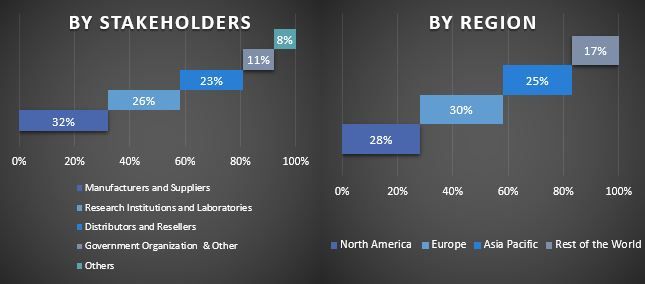
Разработка рынка
Метод триангуляции данных был использован для завершения общей оценки рынка и получения точных статистических данных для каждого сегмента и подсегмента глобального рынка титраторов нового поколения. Данные были разделены на несколько сегментов и подсегментов после изучения различных параметров и тенденций в продукте, конечном пользователе и регионах глобального рынка титраторов нового поколения.
Основная цель исследования глобального рынка титраторов нового поколения
В исследовании были точно определены текущие иamp; будущие рыночные тенденции глобального рынка титраторов нового поколения. Инвесторы могут получить стратегические сведения, чтобы основывать свои решения об инвестициях на качественном и количественном анализе, проведенном в исследовании. Текущие и будущие рыночные тенденции определили общую привлекательность рынка на региональном уровне, предоставив промышленным участникам платформу для использования неиспользованного рынка и получения выгоды от преимущества первопроходца. Другие количественные цели исследований включают в себя:
- Анализ текущего и прогнозного размера рынка глобального рынка титраторов нового поколения в стоимостном выражении (доллары США). Кроме того, проанализируйте текущий и прогнозный размер рынка различных сегментов и подсегментов.
- Сегменты в исследовании включают области продукта, конечного пользователя и регионы.
- Определение и анализ нормативно-правовой базы для отрасли.
- Анализ цепочки создания стоимости, связанной с присутствием различных посредников, а также анализ поведения клиентов и конкурентов в отрасли.
- Анализ текущего и прогнозного размера рынка глобального рынка титраторов нового поколения для основных регионов.
- Основные страны регионов, изученные в отчете, включают Азиатско-Тихоокеанский регион, Европу, Северную Америку и остальной мир.
- Профили компаний глобального рынка титраторов нового поколения и стратегии роста, которые игроки принимают для поддержания устойчивости на быстрорастущем рынке.
- Углубленный анализ отрасли на региональном уровне
Часто задаваемые вопросы Часто задаваемые вопросы
Q1: Каков текущий размер рынка и потенциал роста глобального рынка титраторов нового поколения?
Q2: Какие движущие факторы роста глобального рынка титраторов нового поколения?
Q3: Какой сегмент имеет наибольшую долю на мировом рынке титраторов нового поколения по категориям продукции?
Q4: Какие новые технологии и тенденции наблюдаются на глобальном рынке титраторов нового поколения?
Q5: Какой регион будет доминировать на мировом рынке титраторов нового поколения?
Связанные Отчеты
Клиенты, купившие этот товар, также купили

